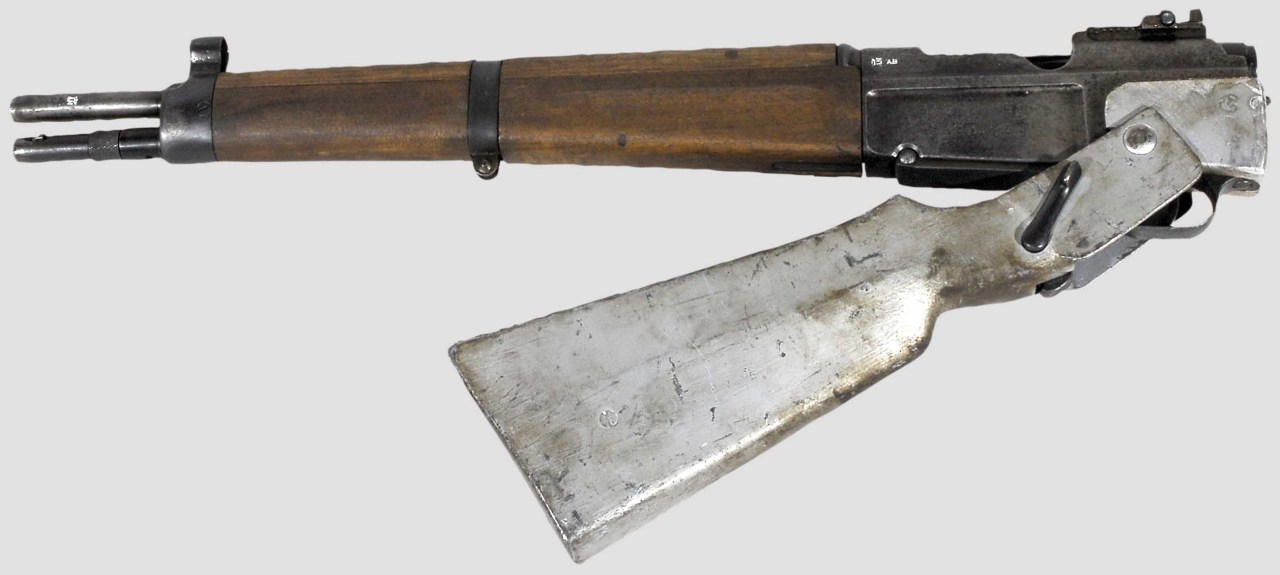. The 1st Parachute Regiment (or 1st RCP) is recognized as the oldest of the French parachute regiments1. It was established in 1943 in Morocco. He distinguished himself during the campaigns for the liberation of France, Indochina and Algeria. He has been based in Pamiers (Ariège) since 1999.
This elite regiment currently belongs to the 11th Parachute Brigade.
As one of the heirs of the Air Force’s parachute units, the 1st RCP is the only parachute regiment in the Army to retain traces of its origin in the Air Force, as evidenced by the “scavengers”, symbolizing sparrowhawks, placed on the shoulder sheaths of uniforms. Similarly, the insignia of this regiment comes directly from that of the 601st GIA, Air Infantry Group, with a blue star.
Since its departure from Jebsheim (Haut-Rhin), the 1st Parachute Regiment has been based in Pamiers in the Ariège. .
 The CR39 (“crosse repliable”, or folding stock) is the paratrooper version of the MAS 36. The need for a more compact and transportable pattern was recognized almost as soon as the MAS 36 was finalized, originally for paratroops but in practice also for alpine troops. Two years were spent devising the new rifle, starting in 1937, and in 1939 is was formally adopted. The barrel was shortened about 5 inches (from 575mm to 450mm), and the wooden stock replaced by a cast aluminum stock that folded underneath the action. A unique and very cool sling design went Alon with the new stock; a spring winder (like a car’s seat belt) was fitted in the stock so that the sling would coil up neatly as the stock was folded. These winders are rather fragile, however, and usually broken today.
The CR39 (“crosse repliable”, or folding stock) is the paratrooper version of the MAS 36. The need for a more compact and transportable pattern was recognized almost as soon as the MAS 36 was finalized, originally for paratroops but in practice also for alpine troops. Two years were spent devising the new rifle, starting in 1937, and in 1939 is was formally adopted. The barrel was shortened about 5 inches (from 575mm to 450mm), and the wooden stock replaced by a cast aluminum stock that folded underneath the action. A unique and very cool sling design went Alon with the new stock; a spring winder (like a car’s seat belt) was fitted in the stock so that the sling would coil up neatly as the stock was folded. These winders are rather fragile, however, and usually broken today.
A small number of CR39s were produced before the 1940 armistice, and production restarted almost immediately upon liberation of St Etienne. The CR39 would remain in production until 1960, with almost 34,000 made in total. . * In 1939, at the beginning of the Second World War, the 601st GIA moved to the Pujaut air base (Gard) and the 602nd GIA to Montélimar8. Together, they formed an Air Infantry Group which was placed in general reserve. In March 1940, they formed a marching company that carried out corps francs missions for the benefit of the 28th Alpine Division. On 23 June 1940, the group withdrew to the White House, near Algiers. It was disbanded on 24 August without having made an operational jump.

- Air Infantry Company No. 1 was formed in March 1941, bringing together men from the 601st and 602nd GIA (Air Infantry Groups) in Oued-Smar near Algiers. It was commanded by Captain Sauvagnac.
- on December 24, 1942, Warrant Officer Guilhemjouan (Brevet No. 131) and Corporal Vullierme (Brevet No. 270) accompanied the demolition platoon of the 2/509th Parachute Infantry Regiment, commanded by Lieutenant De Leo, during the raid on El Djem, in the Tebessa region. The operation was a fiasco, but the two Frenchmen were among the survivors who returned after many adventures. These two paratroopers were therefore the first soldiers of the future 1st RCP to have made an operational jump, followed on 15 August 1944 by the sixteen other parachute hunters who accompanied Captain Boffy as well as eleven commandos of the Shock Battalion, to officially serve as interpreters for the 9,700 airborne personnel of General Frederick’s First AirBorne Task Force Force Rugby of the Provence Landings.
- In January 1943, shortly after the Allied landings in North Africa, Company No. 1 embarked for Fez in Morocco. The command transformed it into the 1st BCP (first battalion of parachute hunters) under the orders of Commander Sauvagnac.
- On 1 June 1943, the 1st Parachute Regiment was created, still under the orders of Major Sauvagnac. Modelled on the American model, the 1st RCP was attached to the 82nd Airborne Division. It was stationed at Oujda alongside the 505th Parachute Infantry Regiment of the U.S. Army.
- 3 October 1944: baptism of fire in Ferdrupt in the [Vosges]
 (Vosges (département) — Wikipédia). Integrated into the 1st DB, he arrived at the battlefield in trucks.
(Vosges (département) — Wikipédia). Integrated into the 1st DB, he arrived at the battlefield in trucks. - 16 October 1944: capture of the Col du Ménil, fighting on Hill 1008 (a monument has been erected to the regiment)
- From 13 to 21 December 1944: fighting around the Colmar perimeter
- 7 January 1945: Defence of Strasbourg
- From 25 to 29 January 1945: capture of Jebsheim (Colmar pocket)
- 2 February 1945: capture of Colmar
Among those killed, twelve officers perished while serving in the 1st RCP between 1943 and 19459.